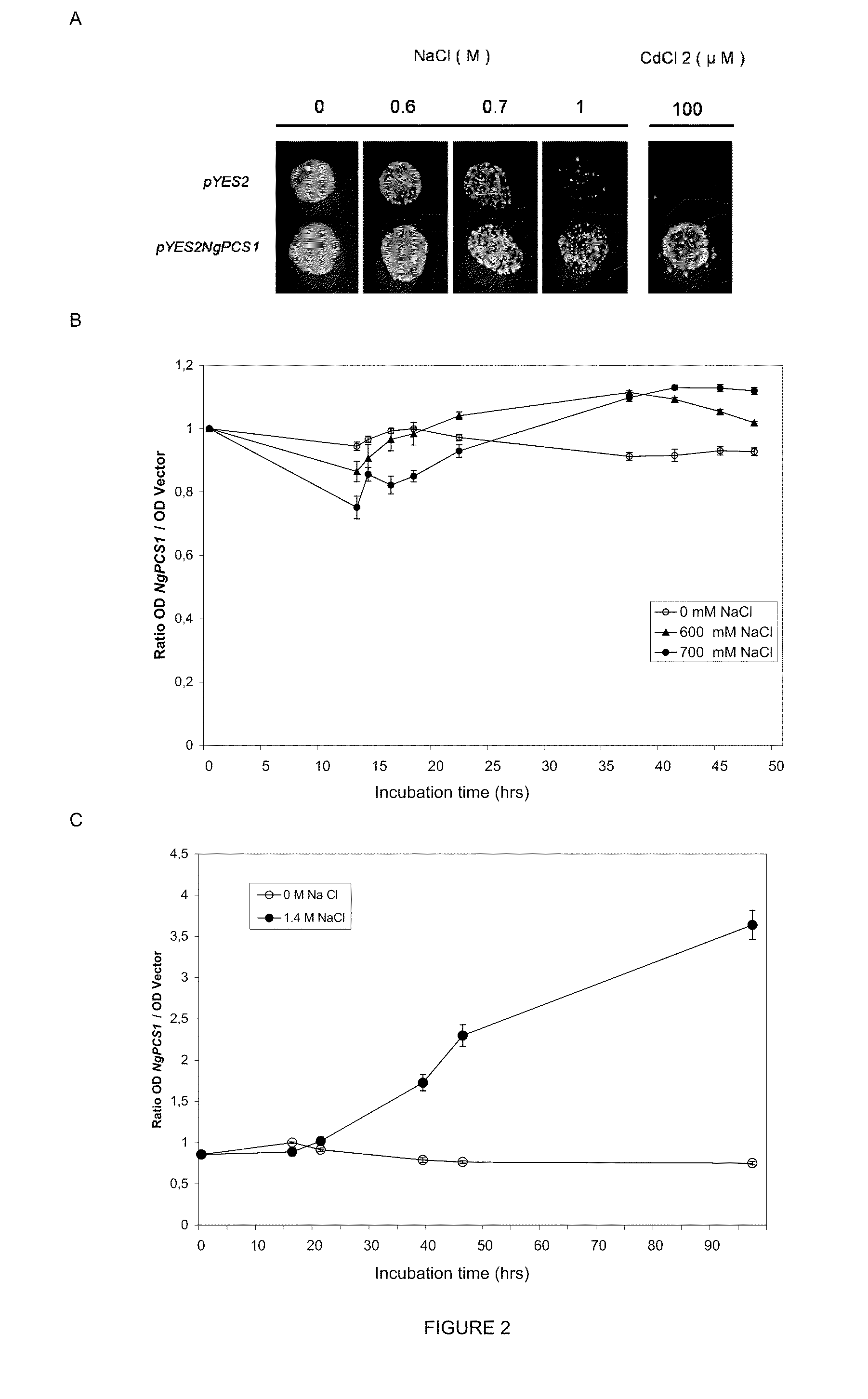Method for improving salinity tolerance
a salinity tolerance and salinity technology, applied in the field of molecular biology, can solve the problem that the migration of salts to deeper horizons is not the solution to the problem
- Summary
- Abstract
- Description
- Claims
- Application Information
AI Technical Summary
Problems solved by technology
Method used
Image
Examples
example 1
Phytochelatine Synthase from N. glauca is Very Similar to the N. tabacum Homologous
[0066]The design of primers in conserved zones of the encoding region of the PCS gene of N. tabacum led to the amplification of a PCR fragment of an expected size (1.5 Kb). The open reading frame codified a protein (NgPCS1) with a molecular mass of 55.14 kD; 501 residues of amino acids and a pH of 6.32. The hydropathy profile was correlated to a cytoplasmatic protein (FIG. 1B). The new protein was compared to the PCS of A. thaliana (access number AAD16046.1), N. tabacum (access number AY235426) and T. aestivum (access number AAD50592.1), resulting in the following identity percentage: 96% in relation to NtPCS1, 64% in comparison to AtPCS1 and 59% to TaPCS1. This high identity among the sequences of PCSs in plants belonging to different families such as Brassicaceae, Poaceae y Solanaceae, indicated an elevated conservation and, thus, an important role of these proteins in the vegetal kingdom. The ident...
example 2
Over Expression of NgPCS1 in Yeasts Leads to a Tolerance to Cd2+ and an Accumulation and Tolerance to Na+
[0067]Cloning and research of different PCSs led to the conclusion that these genes can confer accumulation and tolerance to Cd2+ (Clemens S. et al. (1999) EMBO J. 18: 3325-3333. 27). As expected, NgPCS1 can also confer tolerance to Cd2+. This is especially evident in this work from the experiments carried out at a 100 μM concentration (FIG. 2A). This fact totally agrees with former results obtained wherein the over expression of TaPCS1 was generated in yeasts in similar Cd2+ concentration conditions and using the same vector (Clemens S. et al. (1999)), thus establishing an homologous function of both genes TaPCS1 and NgPCS1 as well as a structural similarity.
[0068]NgPCS1 conferred tolerance to Na+ when it over-expressed in yeasts in concentrations of NaCl oscilating from 0.6 to 1 M (FIG. 2A), indicating a relevant function for this type of enzyme in tolerance to saline stress be...
example 3
Phytochelatines Confer Tolerance to Na+ in Plants and Diminish Oxidating Stress
[0069]To examine the capacity of PCS to improve the tolerance to Na+ in plants, N. glauca specimens over expressing wheat PCS (TaPCS1) previously tested to determine the accumulation of heavy metals, were grown. Gisbert C. et al. (2003) Biochem Biophys Res Commun 303:440-445) (Martinez M. et al. J (2006) Chemosphere 64:478-48524).
[0070]The binary vector pBI121 (Clontech) was used for the transformation. The GUS gene of the binary vector was substituted by the encoding DNA of wheat phytochelatine synthase TaPCS1 through the BamHI and ECL13611 restriction sites. Next, the introduction of the obtained plasmid, containing the TaPCS1 cDNA in Agrobacterium tumefaciens C58C1 RifR was carried out, and afterwards the transference by infection of N. glauca plants was carried out. The new construction was electropored in Agrobacterium tumefaciens cells. The transformants were selected in LB plates with kanamicine an...
PUM
| Property | Measurement | Unit |
|---|---|---|
| diameter | aaaaa | aaaaa |
| pH | aaaaa | aaaaa |
| pH | aaaaa | aaaaa |
Abstract
Description
Claims
Application Information
 Login to View More
Login to View More - R&D
- Intellectual Property
- Life Sciences
- Materials
- Tech Scout
- Unparalleled Data Quality
- Higher Quality Content
- 60% Fewer Hallucinations
Browse by: Latest US Patents, China's latest patents, Technical Efficacy Thesaurus, Application Domain, Technology Topic, Popular Technical Reports.
© 2025 PatSnap. All rights reserved.Legal|Privacy policy|Modern Slavery Act Transparency Statement|Sitemap|About US| Contact US: help@patsnap.com



